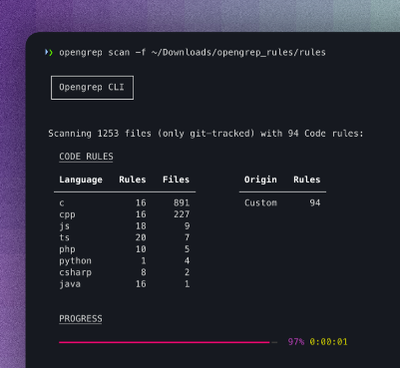
Security News
Opengrep Emerges as Open Source Alternative Amid Semgrep Licensing Controversy
Opengrep forks Semgrep to preserve open source SAST in response to controversial licensing changes.
foreground-child
Advanced tools
Run a child as if it's the foreground process. Give it stdio. Exit when it exits.
The foreground-child npm package is used to run a child process in the foreground, ensuring that signals such as SIGINT, SIGTERM, and exit codes are properly forwarded from the child process to the parent. This is particularly useful when you want to ensure that a child process is treated as if it were the main process, especially in the context of command-line tools and scripts.
Running a child process in the foreground
This feature allows you to run a child process as if it were the main process. The code sample demonstrates how to use foreground-child to run a Node.js script in the foreground.
const foregroundChild = require('foreground-child');
const cmd = 'node';
const args = ['my-script.js'];
foregroundChild(cmd, args);cross-spawn is a cross-platform solution for spawning child processes with support for handling command line arguments properly. It is similar to foreground-child in that it deals with child processes, but it does not specifically focus on running them in the foreground.
execa is a wrapper for child_process methods that provides a more user-friendly API. It supports synchronous and asynchronous execution of child processes and also allows for running processes in the foreground, similar to foreground-child, but with additional features such as promise support and result parsing.
child-process-promise provides promise-based wrappers for the child_process module. While it simplifies working with asynchronous child processes, it does not have a specific focus on running child processes in the foreground like foreground-child does.
Run a child as if it's the foreground process. Give it stdio. Exit when it exits.
Mostly this module is here to support some use cases around
wrapping child processes for test coverage and such. But it's
also generally useful any time you want one program to execute
another as if it's the "main" process, for example, if a program
takes a --cmd argument to execute in some way.
import { foregroundChild } from 'foreground-child'
// hybrid module, this also works:
// const { foregroundChild } = require('foreground-child')
// cats out this file
const child = foregroundChild('cat', [__filename])
// At this point, it's best to just do nothing else.
// return or whatever.
// If the child gets a signal, or just exits, then this
// parent process will exit in the same way.
You can provide custom spawn options by passing an object after the program and arguments:
const child = foregroundChild(`cat ${__filename}`, { shell: true })
A callback can optionally be provided, if you want to perform an action before your foreground-child exits:
const child = foregroundChild('cat', [__filename], spawnOptions, () => {
doSomeActions()
})
The callback can return a Promise in order to perform asynchronous actions. If the callback does not return a promise, then it must complete its actions within a single JavaScript tick.
const child = foregroundChild('cat', [__filename], async () => {
await doSomeAsyncActions()
})
If the callback throws or rejects, then it will be unhandled, and node will exit in error.
If the callback returns a string value, then that will be used as
the signal to exit the parent process. If it returns a number,
then that number will be used as the parent exit status code. If
it returns boolean false, then the parent process will not be
terminated. If it returns undefined, then it will exit with the
same signal/code as the child process.
The "normal" standard IO file descriptors (0, 1, and 2 for stdin, stdout, and stderr respectively) are shared with the child process. Additionally, if there is an IPC channel set up in the parent, then messages are proxied to the child on file descriptor 3.
In Node, it's possible to also map arbitrary file descriptors into a child process. In these cases, foreground-child will not map the file descriptors into the child. If file descriptors 0, 1, or 2 are used for the IPC channel, then strange behavior may happen (like printing IPC messages to stderr, for example).
Note that a SIGKILL will always kill the parent process, but will not proxy the signal to the child process, because SIGKILL cannot be caught. In order to address this, a special "watchdog" child process is spawned which will send a SIGKILL to the child process if it does not terminate within half a second after the watchdog receives a SIGHUP due to its parent terminating.
On Windows, issuing a process.kill(process.pid, signal) with a
fatal termination signal may cause the process to exit with a 1
status code rather than reporting the signal properly. This
module tries to do the right thing, but on Windows systems, you
may see that incorrect result. There is as far as I'm aware no
workaround for this.
foreground-child/proxy-signalsIf you just want to proxy the signals to a child process that the
main process receives, you can use the proxy-signals export
from this package.
import { proxySignals } from 'foreground-child/proxy-signals'
const childProcess = spawn('command', ['some', 'args'])
proxySignals(childProcess)
Now, any fatal signal received by the current process will be proxied to the child process.
It doesn't go in the other direction; ie, signals sent to the
child process will not affect the parent. For that, listen to the
child exit or close events, and handle them appropriately.
foreground-child/watchdogIf you are spawning a child process, and want to ensure that it isn't left dangling if the parent process exits, you can use the watchdog utility exported by this module.
import { watchdog } from 'foreground-child/watchdog'
const childProcess = spawn('command', ['some', 'args'])
const watchdogProcess = watchdog(childProcess)
// watchdogProcess is a reference to the process monitoring the
// parent and child. There's usually no reason to do anything
// with it, as it's silent and will terminate
// automatically when it's no longer needed.
FAQs
Run a child as if it's the foreground process. Give it stdio. Exit when it exits.
The npm package foreground-child receives a total of 17,456,723 weekly downloads. As such, foreground-child popularity was classified as popular.
We found that foreground-child demonstrated a healthy version release cadence and project activity because the last version was released less than a year ago. It has 3 open source maintainers collaborating on the project.
Did you know?

Socket for GitHub automatically highlights issues in each pull request and monitors the health of all your open source dependencies. Discover the contents of your packages and block harmful activity before you install or update your dependencies.

Security News
Opengrep forks Semgrep to preserve open source SAST in response to controversial licensing changes.

Security News
Critics call the Node.js EOL CVE a misuse of the system, sparking debate over CVE standards and the growing noise in vulnerability databases.

Security News
cURL and Go security teams are publicly rejecting CVSS as flawed for assessing vulnerabilities and are calling for more accurate, context-aware approaches.